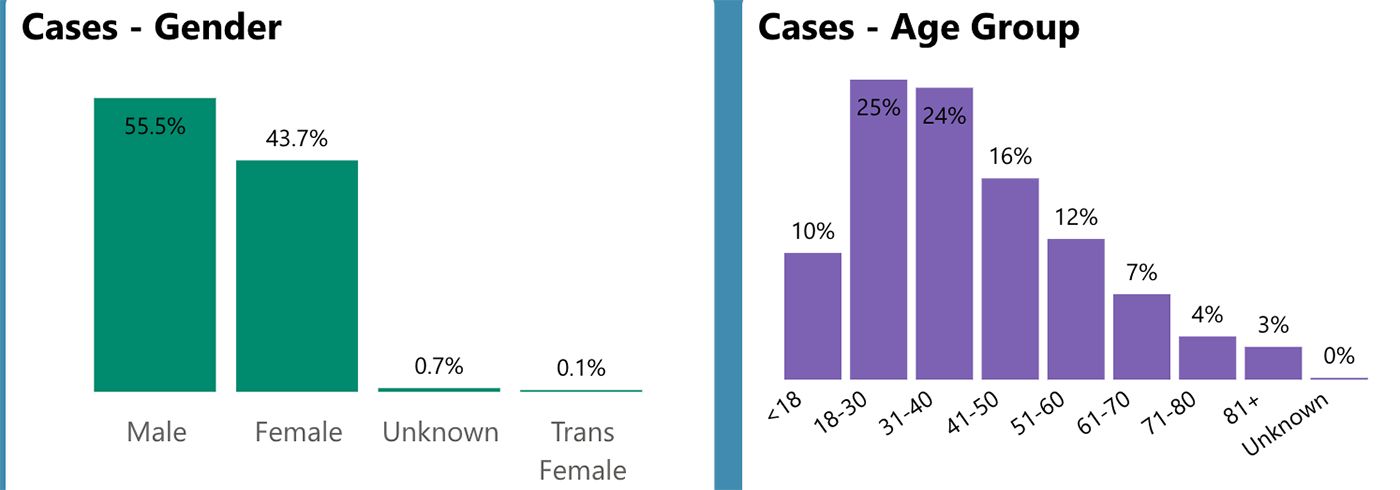The shift in demographics of the COVID-19 pandemic over the last two months is now abundantly clear: Young adults in California between the ages of 18 and 40 appear to be the primary carriers and spreaders of the virus. And while they may require hospitalization in fewer numbers than older adults, they are far from immune from the serious symptoms that leave people debilitated for months, or longer.
Mask-wearing is now mandated in public spaces across much of California. But stories of house parties with no distancing precautions being taken have been rampant, both anecdotally and documented in the news. People are gathering in groups every day this summer in Dolores Park — weather permitting — and not wearing masks while they picnic. And, perhaps most significantly, younger adults are often the ones doing "essential" jobs that require them to work outside their homes and interact with a lot of other people to make money.
As of last week, younger people between the ages of 18 and 40 represented 49 percent of all COVID-19 cases in San Francisco, according to data published by the city's Department of Public Health. Meanwhile, people between the ages of 41 and 70 represent just over a third of cases in the city, or 35 percent. For reasons that have still not been definitively determined by researchers, men remain more susceptible than women to infection with the coronavirus.

The trend of younger people being more represented among confirmed cases can be seen statewide, as the Chronicle reports. Between May 1 and August 1, the number of documented cases among Californians between the ages of 18 and 34 shot up nearly 15-fold, from 12,373 to 180,354. And this demographic went from comprising a quarter of the state's cases to 35 percent overall.
In Santa Clara County, similar to San Francisco, people aged 20 to 39 now represent 39 percent of all cases — and a COVID outpatient clinic at Stanford now says that 55 percent of its patients are under the age of 40, up from 25 percent in April.
The likelihood of having a severe COVID case requiring hospitalization is somewhat lower among young adults than older ones, however a July study by UCSF suggests that one in three young people is still susceptible to such a severe case — with smoking being the primary risk factor.
The Chronicle spoke to one 27-year-old COVID patient, Tyler Lopez of Riverside, who admits he was not concerned about becoming infected before he was back in June.
"I was like, ‘It’s not that big of a deal, whatever, if I get it, I get it,'" Lopez tells the paper. But two months and two hospital stays later, after experiencing an infection in the tissue surrounding his heart that nearly led to cardiac arrest, Lopez is hoping to spread the word of the virus's seriousness. "It jacked me up,” he says. “I wouldn’t wish this on my worst enemy."
While the number of cases among young people has clearly skyrocketed in California, it's still hard to point to particular activities or places as the main vectors for disease transmission. Alameda County officials recently cracked down on outdoor gatherings that were happening at Lake Merritt, blaming them for potential disease spread. But county health officer Nicholas Moss told the Chronicle last week that they simply don't have the data to pinpoint sources of transmission, outside of workplaces, in some cases. And the types of data being published publicly vary widely from county to county, which leads to big gaps in understanding when and where spreading events may be occurring. (And as the New York Times reported at the national level, "Coronavirus outbreaks have been traced to funerals, fast food restaurants, cruise ships and Navy vessels. But most of the biggest known clusters have been in nursing homes, food processing plants and correctional facilities.")
"To really get at where transmission occurs, you have to get to a level of epidemiology that particularly in a pandemic response just isn’t possible," Moss told the Chronicle. "We don’t have the capacity. We’re trying to make the best possible interpretations of the information available."
Santa Clara County public health officer Dr. Sara Cody nonetheless called out the trend of younger people spreading the virus back in July, saying at a board of supervisors' meeting that "It's where the epidemic is spreading the most quickly... This is disproportionately accelerating among young adults."
San Francisco is a city full of young people, many with jobs that let them work from home and plenty of disposable income. So whether it's dining out in groups at sidewalk tables or taking the party home to living rooms and backyard afterwards because the bars are closed, it seems clear that there needs to be a shift back toward fear and caution as the pandemic wears on. Wear masks even with friends! Don't hang out indoors or in groups bigger than five or six people! Otherwise the case surge in July will just repeat itself, and you will have to read another twenty articles like this one in September.
Related: Outspoken San Mateo Health Officer Calls State's Watch-List Process 'Arbitrary' and 'Misdirected'
Photo: Justin Sullivan/Getty Images

